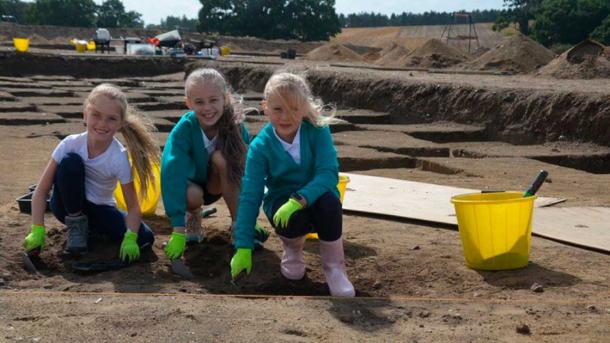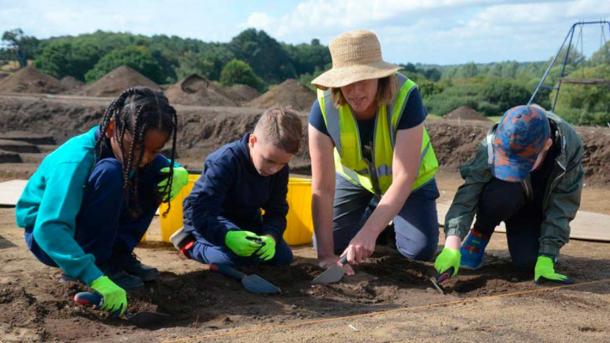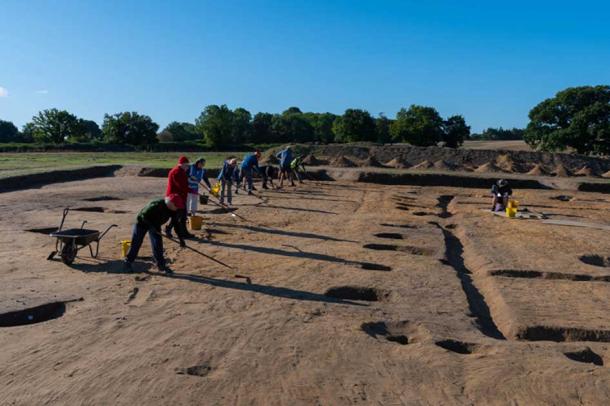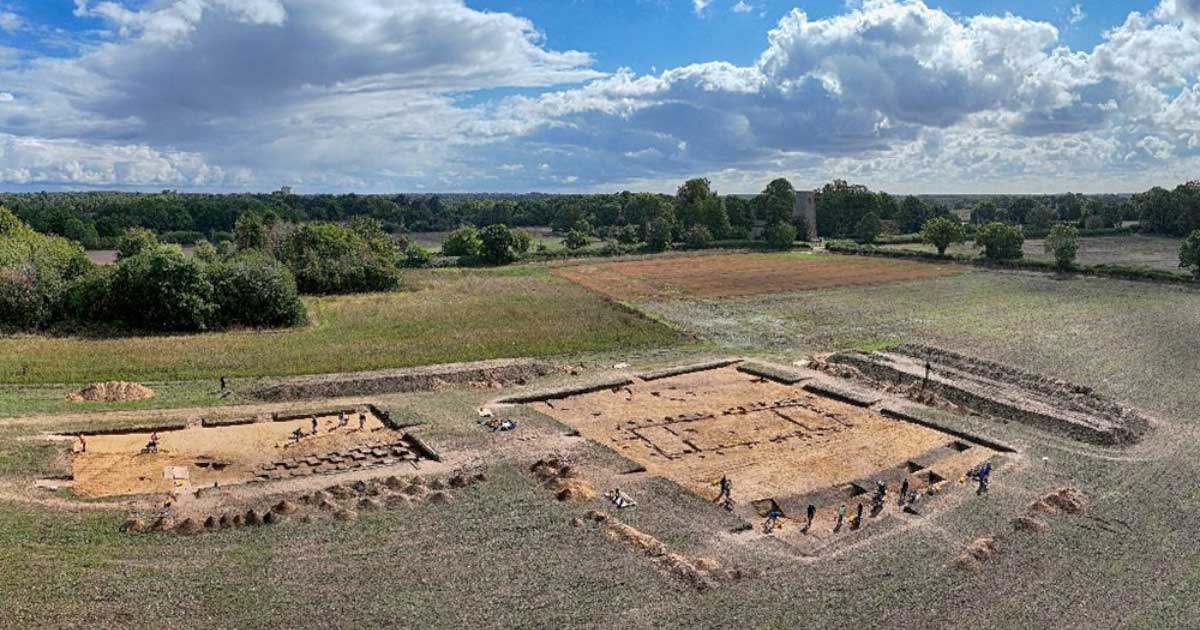1,400-Year-Old Royal Hall of East Anglian Kings Unearthed in Suffolk
An ongoing community archaeology project in southeast Suffolk, known as Rendlesham Revealed, has uncovered a royal hall “of international importance” dating back 1,400 years. Termed the “Hall of the First Kings of East Anglia,” it was first identified by aerial photography in 2015 by an earlier pilot community project.
Excavations over the summer of 2022 revealed the remains of a timber hall in a settlement area of 123 acres (49.8 hectares), measuring 23 x 10 meters (75.4 x 32.8 feet). Suffolk County Council announced that the royalty of this site was confirmed by the writings of the 8th-century Venerable Bede. The Venerable Bede, or Saint Bede, was an English monk at the monastery of St. Peter and St. Paul in the Kingdom of Northumbria of the Angles.

Children from Rendlesham Primary School who helped with the dig which unearthed the royal hall at Rendlesham. (Suffolk County Council)
The Royal Hall Unearthed in Rendlesham was Part of a Royal Compound
Traces of earlier settlements from the Roman Period, dating back to around the 1st century AD, and the early Neolithic period, in the 4th millennium BC, were also found at the site. Over 250 volunteers participated in the dig, in which primary school children from Rendlesham, Eyke, and Wickham Market were also involved.
- Rendlesham Royal Palace Linked to Famous Sutton Hoo Burial Site
- Mementos for the Dead: Surprising Burial Customs in Iron Age Britain
“The results of this season's excavation are of international importance,” explained Professor Christopher Scull, the project's principal academic advisor when discussing the royal hall unearthed in Suffolk. “Rendlesham is the most extensive and materially wealthy settlement of its date known in England, and excavation of the hall confirms that this is the royal residence recorded by Bede.”

The community archaeology project in Suffolk involved hundreds of volunteers over the summer of 2022. (Suffolk County Council)
Scull went onto contextualize this find in the larger annals of English history. Rendlesham serves as an example of an early English royal center, accompanied by an intricate assembly of metalwork, that provides a glimpse into the socioeconomic landscape and lives of its inhabitants. It helps modern historians re-write how sophisticated, complex, and internationally placed society would have been 1,400 years ago. He further described the find as the “most extensive and materially wealthy settlement of its date known in England.”
Between 570 and 720 AD, this royal center served as the focal point of a major province of the East Anglian kingdom. It focused on the River Deben valley, from where it ruled. Bede’s writings helped identify Rendlesham as the place of East Anglian King Aethelwold and when he stood sponsor at King Swithelm’s baptism of the East Saxons between 655 and 663 AD, reports the BBC.
A perimeter ditch was also found around the royal compound. It housed remains of food preparation and feasting, showing a consumption of vast quantities of beef, pork, and other meat, along with dress jewelry, personal items, fragments of glass drinking vessels, and pottery.

Fully excavated post holes on the east side of the royal hall unearthed at Rendlesham with volunteers cleaning the trench for post excavation photography. (Suffolk County Council)
Rendlesham Revealed: Kingship, Class, and Power
The Rendlesham Revealed community archaeology project, ongoing from 2020 and scheduled until 2024, will help uncover the history of the East Anglian kingdom. Provisional analysis and research will reveal the full extent of the discoveries by 2023. The erstwhile kingdom covered modern-day Suffolk and Norfolk, and saw extensive travel between the various provinces by kings who wanted to be seen by the people.
They would be accompanied by their household and a huge retinue of personal staff. These visits would serve the purposes of administering justice, receiving tribute and diplomatic envoys, feasting with their followers, and distributing gifts and favors.
“It can't be underestimated how important this part of Suffolk is to understanding our local and national heritage,” stressed the Conservative councilor Melanie Vigo di Gallidoro, the authority's cabinet member for protected landscapes and archaeology, when discussing the royal hall discovery at Rendlesham.
- Workshop Discovered Near Famous Sutton Hoo Ship Burial
- High Status Anglo-Saxon Burials in Suffolk Linked to Ancient King of East Anglia
Over the last few years, the Sutton Hoo burial ground has shed light on the royal burials associated with the Kings of East Anglia, described as their version of the famed “Valley of Kings.” This is why it is expected that the Rendlesham compound will reveal several other such royal buildings, which the Rendlesham Revealed project hopes to uncover.
“It has been wonderful working with our terrific team of partners and volunteers, who should be proud of what they have achieved,” concluded Professor Scull. “Their work is a major advance in our understanding of the early East Anglian Kingdom and the wider North Sea world of which it was a part.”
Top image: Drone photograph of the excavations of the royal hall unearthed at Rendlesham. Source: Suffolk County Council
By Sahir Pandey



















